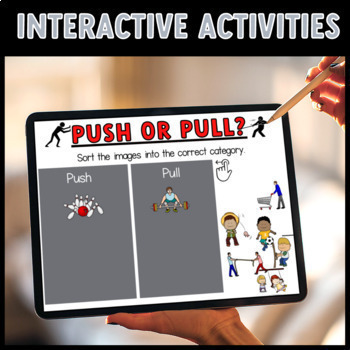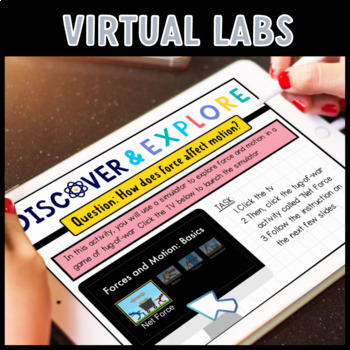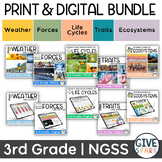Forces and Motion - DIGITAL - third grade - complete science unit - NGSS Aligned
- PDF
- Google Apps™

What educators are saying
Also included in
- PRINT and DIGITAL - Forces and Motion - Third Grade Science Bundle - NGSSThis comprehensive bundle unit is specifically designed for third-grade students to learn about the topic of Forces and Motion.STANDARDS ALIGNMENT:The unit consists of 11 engaging lessons that incorporate hands-on activities. IPrice $22.50Original Price $28.95Save $6.45
- 3rd Grade - DIGITAL BUNDLE - NGSS Aligned - Five Science Units - Year LongDiscover a seamless blend of science and digital learning with our 3rd Grade Digital Science Bundle. Aligned with the Next Generation Science Standards (NGSS), this bundle offers five essential science units for third-grade sPrice $55.00Original Price $65.00Save $10.00
- Third Grade NGSS: The Ultimate Teaching Bundle – Print & Digital!Get ready for an exciting science journey with this all-in-one bundle, perfect for third-grade teachers. This package includes FIVE highly engaging science units, all aligned with the NGSS standards. In this package, you will receiPrice $110.00Original Price $144.75Save $34.75
Description
Forces and Motion - DIGITAL - third grade - complete science unit - NGSS Aligned
Step into the dynamic realm of Forces and Motion with this digital teaching unit tailored for third-grade students. Designed to align with the Next Generation Science Standards (NGSS) for third grade, this interactive unit features 11 comprehensive lessons delivered through engaging Google Slides.
NOTE: You will need a Google account or Google Classroom to access the digital version on Google Slides.
--------------------What's Covered?--------------------
- Lesson 1 - What is a force?
- Lesson 2 - Balanced and Unbalanced Forces
- Lesson 3 - Does mass affect motion?
- Lesson 4 - What is gravity?
- Lesson 5 - What is friction?
- Lesson 6 - Air Resistance
- Lesson 7 - Can we predict motion?
- Lesson 8 - What is magnetism?
- Lesson 9 - Can a magnetic field pass through any material?
- Lesson 10 - What is an electric force?
- Lesson 11 - Electromagnets
--------------------Features--------------------
- Interactive Activities: Engage with 100% interactive content, including drag-and-drop activities, text boxes, audios, videos, and games.
- Reading Tasks with Audio: Dive into a variety of reading tasks with comprehension questions. The option to play an audio version of the reading ensures support for all reading levels.
- Digital/Virtual Labs: Experience a range of labs digitally using online simulators and videos, offering flexibility for in-class or remote teaching.
- Time to Think: Each lesson starts with a critical thinking activity, using questions, video clips, or activities to engage students.
- Games, Videos, and More: Numerous interactive options allow students to further their learning independently.
- Reflection Activities: Conclude each lesson with a reflection activity, where students demonstrate their understanding.
- End of Unit Assessment: Gauge understanding with an interactive Google Slide or Google Forms assessment.
- Answer Key: Save time with a comprehensive answer key available as a Google Slide or PDF.
Format: To ensure a seamless digital experience, this download offers a clickable PDF linking to all the resources. With one click, a copy will be stored directly on your Google Drive.
Please download the preview to get a more detailed understanding of the product.
Customer Support:
- Email me at givesparkco@gmail.com
- submit a help ticket
- ask a question on the Q&A tab
Thank you for stopping by!
Kind regards,
Vicky x








